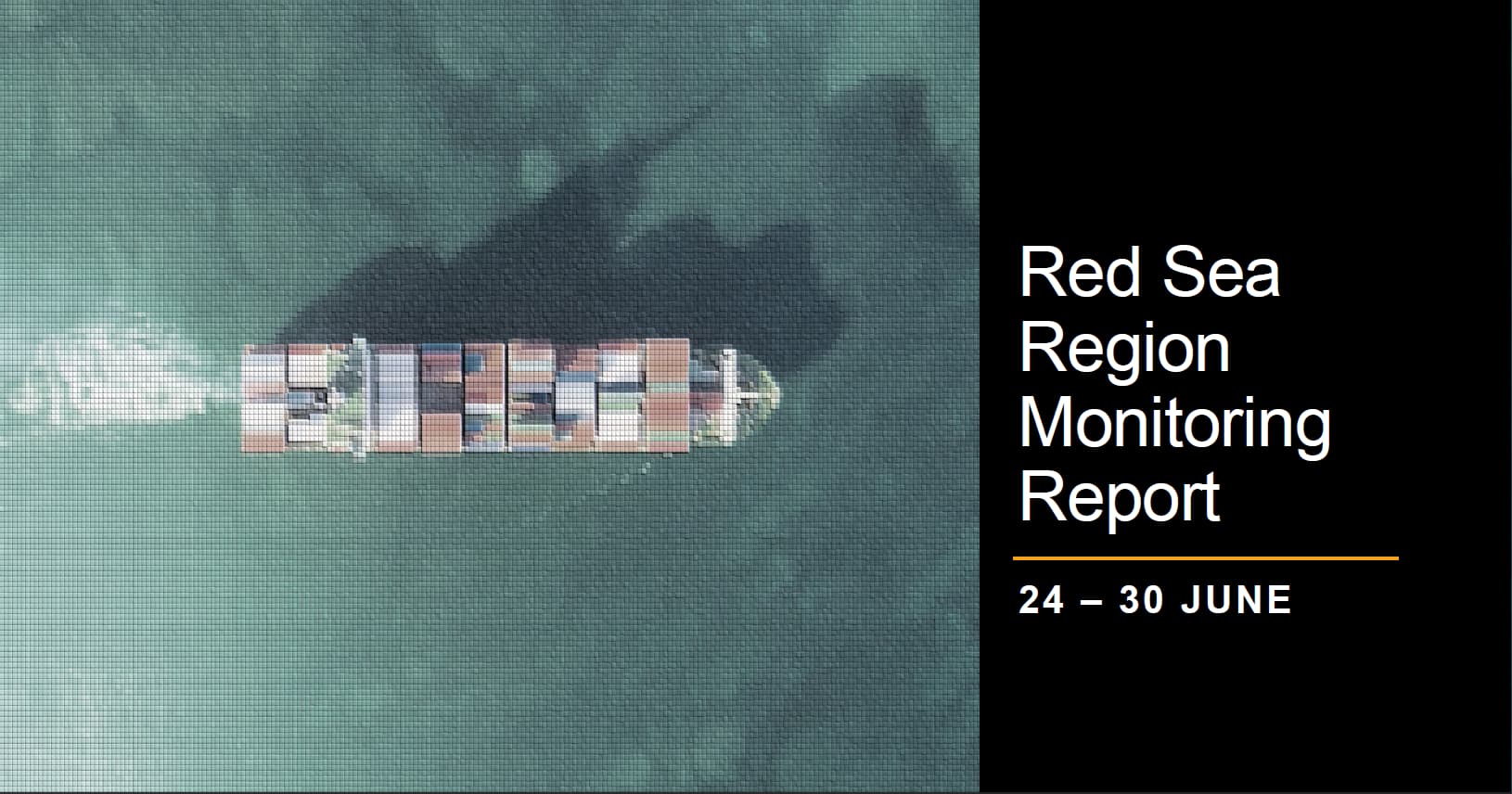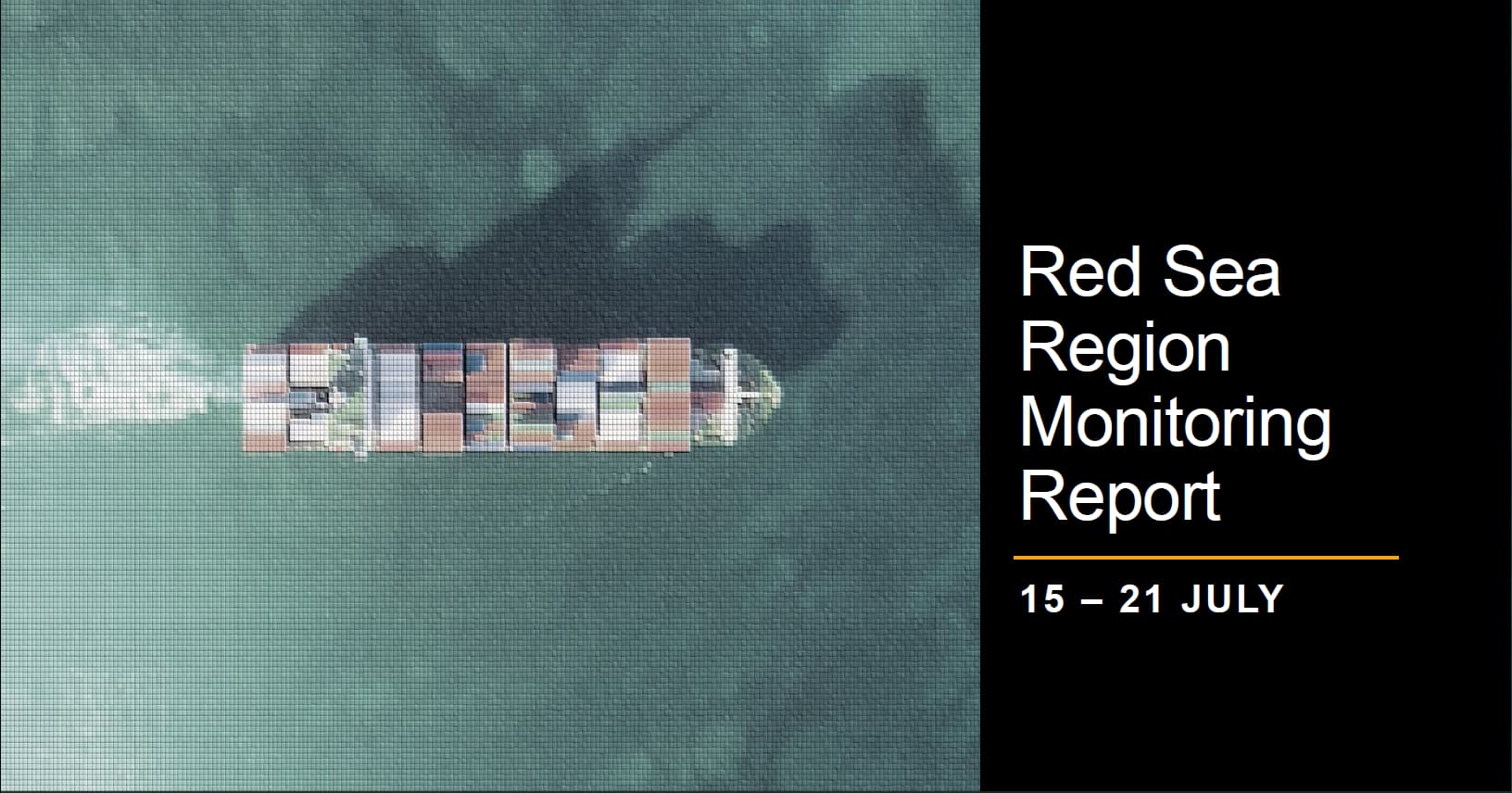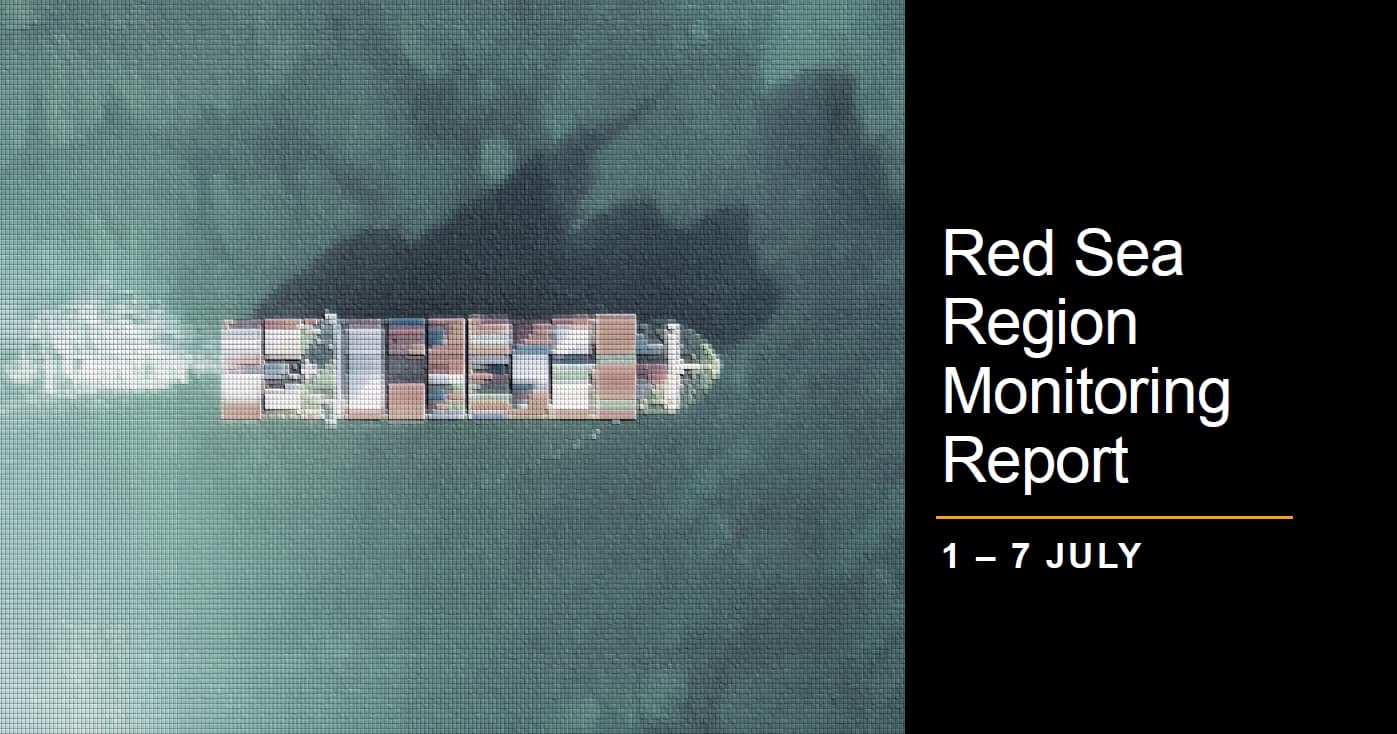KEY DEVELOPMENTS – COMMERCIAL INCIDENTS
During the monitoring period 8-14 April Regal Maritime Solutions (RMS) identified the following incidents in the Red Sea and Gulf of Aden region:
STATE SPONSORED BOARDING (IRANIAN FORCES): On 13 April an incident was reported 50NM north-east of Fujairah, UAE after being seized by regional authorities. The MSC Aries was boarded by Iranian special forces after troops were observed rappelling onto the vessel by helicopter. The Portuguese-flagged vessel is linked to Israeli billionaire Eyal Ofer. The incident occurred prior to Iranian military strikes launched at Israel later the same evening following Israel’s suspected attack on Iran’s consulate in Damascus earlier in the month. AIS tracking data showed the vessel as heading to towards the Strait of Hormuz before it was turned off as a precautionary measure when passing through the region where it was intercepted.
PIRACY INCIDENT: On 14 April Somali pirates released the pirated vessel, the MV Abdullah along with 23 of its crew, after a USD five million ransom was paid, according to the Pirate Action Group (PAG). The MV Abdullah, a Bangladesh-flagged bulk carrier was hijacked 600 NM east of Somalia’s capital Mogadishu in March 2024 whilst it was heading from Mozambique to the United Arab Emirates.
MISSILE ATTACK: On 14 April the Israeli Defense Force (IDF) intercepted an unmanned aerial vehicle (UAV) launched from Yemen near the Israeli port city of Eilat in the Red Sea. Both local social media users and news media reported interceptor missiles being launched from an Israel Navy vessel as part of Israel Iron Dome Air defence system. Sirens were not activated in the city. The Automatic identification system (AIS) interference off Eilat and neighbouring Aqaba, Jordan have been reported and is believed to be electronic warfare counter-measures by the IDF.

KEY DEVELOPMENTS – MILITARY ACTIVITY
During the monitoring period 8-14 April RMS identified the following incidents involving US coalition forces in the Red Sea and Gulf of Aden region, obtained from military and open sources:
MISSILE INTERCEPT: On 7 April (updated on 8 April) at approximately 0800 local time an anti-ship ballistic missile (ASMB) was launched from a Houthi-controlled area of Yemen toward the Gulf of Aden where a coalition ship was escorting M/V Hope Island, a Marshall Islands flagged, U.K. owned, Italian operated cargo ship. No injuries or damage were reported by US, coalition, or commercial ships.
UAV/MISSILE INTERCEPT: On 8 April between 1215 and 1440 local time US forces engaged and destroyed an air defence system primed with two missiles ready to launch at a ground control station in Houthi-controlled areas of Yemen. US forces also destroyed one unmanned aerial system launched by Iranian-backed Houthi terrorists from Yemen over the Red Sea. No injuries or damage were reported by US, coalition, or commercial vessels in the region.
MISSILE INTERCEPT: On 9 April at approximately 0300 local time US navy vessel, the USS Mason engaged and destroyed one inbound anti-ship ballistic missile (ASBM) launched by Houthi militants from Yemen over the Gulf of Aden. The ASBM was likely targeting the MV Yorktown, a U.S.-flagged, U.S.-owned vessel being escorted by the US warships, USS Laboon and USS Mason. There were no reported injuries or damage to US, coalition, or commercial vessels in the area.
UAV INTERCEPT: On 10 April between 0400 and 0600 local time the US military successfully engaged three unmanned aerial vehicles (UAV) launched from Houthi-controlled areas of Yemen. Two UAVs were launched over the Gulf of Aden and one UAV was launched over the Red Sea. There were no reported injuries or damage reported by vessels in the regions as a consequence of this action.
UAV INTERCEPT: On 10 April between 1950 and 2000 local time, US forces successfully engaged and destroyed eight UAVs in Houthi-controlled areas of Yemen as part of a pre-emptive strike.
MISSILE INTERCEPT: On 11 April at approximately 1300 local times US forces engaged and destroyed one anti-ship ballistic missile (ASBM) launched over the Red Sea from Houthi-controlled areas in Yemen. There were no injuries or damage reported by US, coalition, or commercial ships in the region.
DEFENSIVE ACTION AGAINST IRANIAN & HOUTHI MILITARY STRIKES ON ISRAEL: Between
13 and 14 April US support by European coalition forces, successfully engaged and destroyed more than 80 one-way attack unmanned aerial vehicles (OWA UAV) and at least six ballistic missiles intended to strike Israel from Iran and Yemen. The strikes included a ballistic missile on its launcher vehicle and seven UAVs destroyed on the ground in Iranian-backed Houthi controlled areas of Yemen prior to their launch. The Iranian and Houthi planned strikes were in response to Israel’s suspected attack on the Iranian consulate in Damascus earlier in the month killing senior Iranian military officials.
MISSILE ATTACK: On 14 April the Israeli Defense Force (IDF) intercepted an unmanned aerial vehicle (UAV) launched from Yemen near the Israeli port city of Eilat in the Red Sea. No injuries of damage were reported to any vessels in the region or sites in Israeli territory.
On 14 April the Dutch navy deployed a logistics ship Zr.Ms.Karel Doorman to the Red Sea in support of EUNAVFOR Operation Aspides. The ship will be deployed in the region from early May to mid-August providing fuel and various supplies to European military vessels deployed to the region to protect commercial vessels from Houthi attacks.
KEY DEVELOPMENTS – HOUTHI MISSILE STATISTICS

Figures 1 and 2 identifies the number of missiles, UAV, USVs and UUVs launched, or prepared to be imminently launched, by Houthi militants from Yemen targeting commercial and naval vessels in the Red Sea and Gulf of Aden regions. Figures have incorporated statistics from vessels hit, near misses and pre-emptive strikes on-land in Yemen by US-led Coalition forces but not those resulting from large scale coordinated military action. In some cases the destined target of Houthi weapons including destroyed on-land in Yemen cannot not be verified and has therefore been categorised as ‘Not Known’ (NK). Where no dates are provided there were no reported incidents or data available for that period.
KEY DEVELOPMENTS – SECURITY INCIDENT MAPPING

REGIONAL DEVELOPMENTS
During the monitoring period 8-14 April RMS identified the following key regional developments:
On 13 April Iran launched a large scale coordinated aerial attack from its territory and that of Yemen, Iraq, Syria and Lebanon on Israel utilising a combination of unmanned aerial vehicles (UAVs) and missiles. There were no attacks on US forces or US facilities in the region.
Over 300 UAVs and missiles targeted Israel overnight. 99 percent of the weapons were intercepted, with many interceptions taking place outside of Israel’s borders as a result of efforts by Israeli, US, UK, French and Jordanian forces.
No fatalities were reported in Israel. Israel reported only minor damage including to a military base in Nevatim, southern Israel. One civilian was injured as a consequence of shrapnel wounds. Fewer than 10 ballistic missiles were estimated to have hit Israeli territory.
Iran’s Islamic Revolutionary Guard Corps (IRGC) announced the attacks as part of operation “True Promise”, in retaliation for the 1 April airstrike against the Iranian consulate in Damascus, which killed seven high-ranking IRGC officials and was attributed to Israel. Iran’s method of attack provided Israel and its allies with time to intercept the projectiles with the US and its regional neighbours informed of the attack in advance.
The attack represents an unprecedented escalation by Iran considering this was Tehran’s first-ever strike targeting Israel from Iran territory. It follows a 1 April strike, attributed to Israel, on the Iranian consulate in Damascus (Syria) which killed a several IRGC officials including a senior General.
Airspaces over Israel, Jordan, Kuwait, Iraq and Lebanon were closed during the attack, causing delays and cancellations to commercial flights. All five countries have since reopened their airspace.
On 14 April Iran’s Permanent Mission to the UN announced that its operation had concluded, but added that “should the Israeli regime make another mistake, Iran’s response will be considerably more severe”.
Whilst Iran declared its military action as having been concluded, Israel has indicated to the US and other governments that a military response is “inevitable”.
Israeli’s war cabinet are in favour of taking retaliatory action against Iran but remain divided on the course of action. Meanwhile the US has urged caution to Israel with US President Joe Biden telling Israeli Prime Minister Benjamin Netanyahu to “think carefully and strategically.”
Several Middle Eastern countries have called for restraint following Iran’s attack on Israel amid concern any action by Israel will further deteriorate regional security.
The leaders of the G7 issued a joint statement, after President Biden convened the group on 14 April, condemning Iran’s attack on Israel and reaffirming the group’s commitment to Israel’s security. Meanwhile NATO and EU members condemned Iran’s attack on Israel.
On 14 April the UN Secretary-General Antonio Guterres reminded the international community of the boundaries of international law which should be abided by and calling for actors to ‘step back from the brink as to avoid major military confrontations in the Middle East’. Meanwhile Israel has called for further sanctions on Iran during the UN Security Council meeting.
Biden held conversations with US Congressional leaders urging them to pass an urgent aid package for Israel following Iran’s attack.
The last reported location of the Iranian intelligence vessel the Behshad was on 4 April in the vicinity of coordinates 11° 00′ 34.7″ N, 044° 17′ 39.5″ E located approximately 28.5NM north-east of Lughaya., Somalia.
ASSESSMENT
- Houthi attacks will continue to target commercial and military vessels in the Red Sea and Gulf of Aden but maybe tempered over the coming week due to weapon re-supply issues following its participation in Iran’s attack on Israel.
- Any ceasefire between Israel and Hamas, may see a pause in attacks by the Houthis on commercial shipping. However this may be influenced due to the ongoing Israel-Iran conflict whereby Houthi militants may partake in further strikes on Israeli targets both on its territory and against Israeli, US and UK linked vessels transiting the Red Sea region.
- Israel is highly likely to retaliate, but may take a few days to decide on a response. Israeli retaliation will seek to strike back as soon as possible and will maintain heightened defensive readiness.
- The scope of the Israeli counterattack will dictate the evolution of the war threat. Both the US and Iran have indicated that they do not want to escalate the situation further.
- Israel remains highly capable of intercepting large-scale cross-border missile and drone attacks, in particular given support from allied forces stationed in the region.
- Israel’s response will likely involve targeted strikes against the IRGC bases from which Iran launched projectiles on 13 April. An alternative action would entail a reversion to less direct response amid international efforts to de-escalate.
- Israel will continue to maintain an aggressive posture toward Iran over the coming months and likely to continue to target Iran-associated assets across the region.
- Iran will continue to smuggle weapon components to Houthi militants via shipping vessels and smuggling networks within the territory controlled by Yemen’s internationally recognised government (IRG).
- Houthi use of outdated and inaccurate data pertaining to target identification will likely remain inaccurate in the short term increasing the risk to non Israeli, US or UK linked vessels. Houthi militants are expected to take additional precautions not to target Chinese and Russian vessels in the region.
- The US and its partners will continue to conduct pre-emptive strikes against Houthi targets on-land in an attempt to degrade Houthi military capability and prevent it to be used as a platform to target Israel in support of further potential Iranian attacks.
- The US will continue to intensify efforts to intercept vessels smuggling weapon components from Iran to the Houthis in Yemen and expand intelligence collection methods to enhance maritime interdiction operations, as well as coordinate military strikes against Houthi weapon sites, facilities and capabilities in Yemen.
- The US government will continue to push for a diplomatic solution for the Israel-Hamas conflict with regional partners due to the ongoing humanitarian crisis in Gaza and attempt to dissuade wider conflict from escalating in the region. The US will attempt to maintain this issue as a separate matter to the current Israel-Iranian situation.
- Piracy incidents around the Horn of Africa is expected to continue as a consequence of ongoing insecurity challenges presented in the Red Sea region and the Middle East.
- The Indian navy will continue to utilise coercive measures to resolve piracy incidents and to deter PAG activity in the Indian ocean region.
RECOMMENDATIONS
- Avoid being in vicinity of Iranian Behshad vessel. Avoid where possible transiting locations within the UAE and Iranian coastlines due to the risk from Iranian military boarding parties.
- Be aware of US, coalition or Israeli Navy activity nearby in north of Red Sea, Bab-al-Mandab strait and Gulf of Aden, and Iranian activity in the Arabian sea.
- Vessels operating in the Indian Ocean area are urged to heighten their vigilance due to increased likelihood of Pirate Activity Groups (PAGs) operating in the area.
- Report any Suspicious Sightings and be aware of the risk of Unmanned aerial Vehicle (UAV) / drone and Uncrewed Surface Vehicle (USV) attack.
- Consider utilising a digital monitoring system, which incorporates UAV/UUV drone monitoring to warn of potential attack and use of physical barriers, such as nets and underwater barriers, that can be deployed to prevent UUVs from approaching a ship. These barriers can entangle or obstruct the movement of a UUV..
- Ensure crew conduct drills and training exercises to respond to UUV threats so that they are well-prepared to take appropriate action in the event of an incident.
- Follow guidance on loitering munitions as per the OCIMF website: https://www.ocimf.org/publications/information-papers/loitering-munitions-%E2%80%93-the-threat-to-merchant-ships
- Implement and review BMP5 in particular section 2, which describes non-piracy threats and the Global Anti-Piracy Guide.
- Consider mentioning vessel location to Flag Authorities.
- Inform UKMTO/MSCHoA of vessel movements.
- Ensure radar is kept on.
- Communicate with local agents for any local information or intelligence.
- Keep VHF Ch16 on and pay attention to advisories. Ensure strict surveillance of communications and establish communication with all approaching vessels.
- Do not allow small boats to approach or dock. Consider utilizing an armed security team aboard.
- Ensure there is Hard Cover available if on deck and that it is accessible.
- Ensure a Secondary Muster Station is considered and identified to crew and not just the citadel.
- Maintain Bridge Watches. (Please be aware at night, small, slow vessels without a wake are difficult to detect on radar). Keep Traffic on Upper Deck to a minimum
- Ensure all fire-fighting equipment is checked and available for immediate use. Including the emergency fire pump and that relevant maintenance has been conducted.





